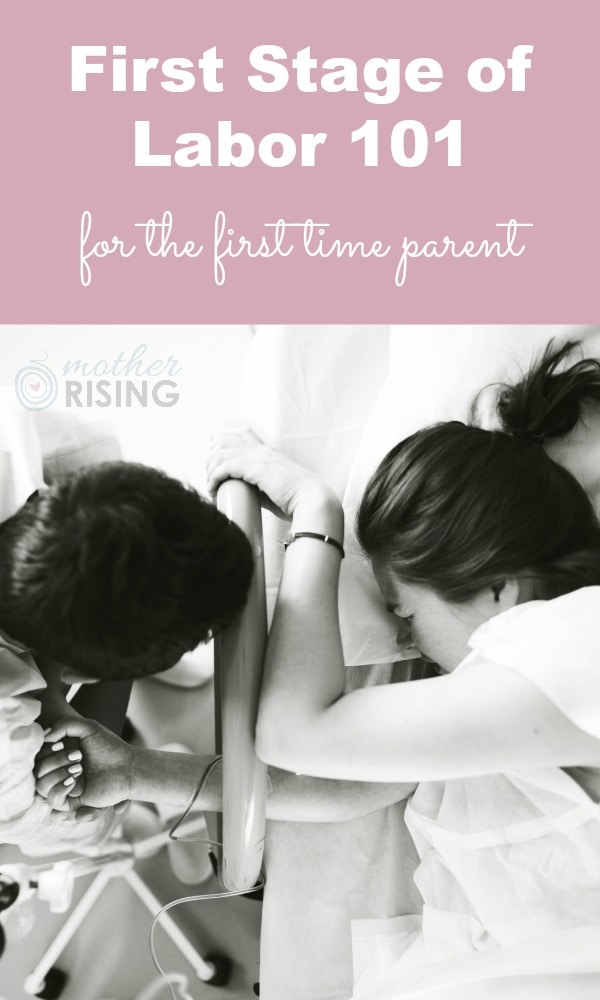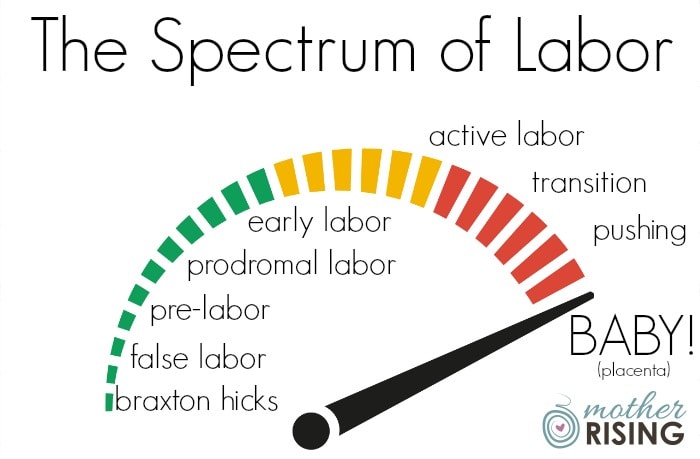The first stage of labor is the longest stage and everything that happens before pushing, birth, and the placenta. Because it’s so long and varied, the first stage of labor is further broken down into three distinct parts – early labor, active labor, and transition.
During the three parts of the first stage of labor, a woman experiences uterine contractions that progress in length, strength, and frequency. These contractions, along with a variety of coping techniques like frequently changing positions and deep breathing, slowly open the cervix and help baby move into the best possible position for pushing.
First Stage of Labor 101 for the First Time Parent
This article describes everything parents need to know about the first stage of labor, including tips on how to have the best birth experience for the whole family.
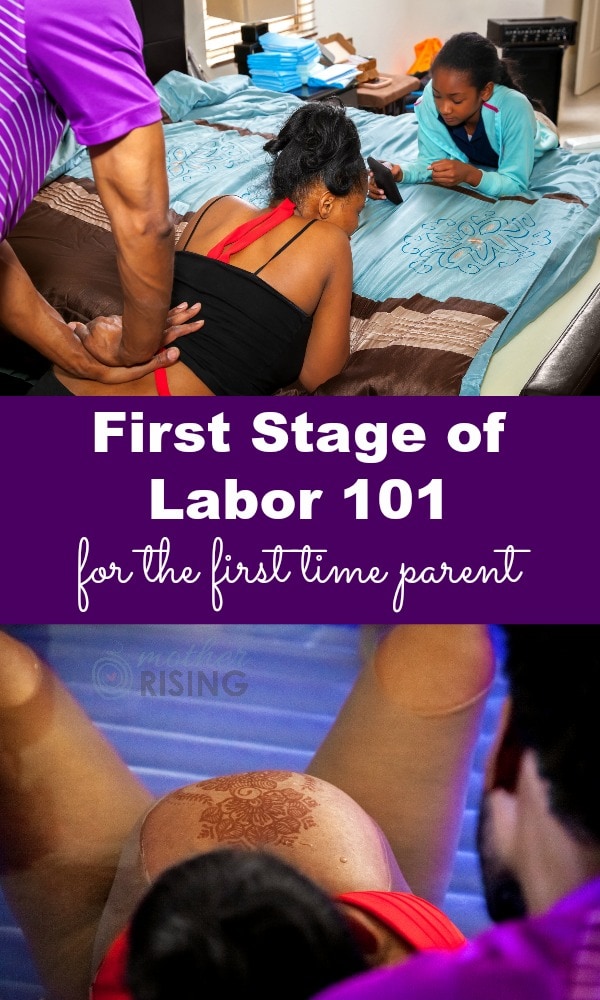
What Are the Three Stages of Labor?
Before getting into the nitty gritty of the first stage of labor, it’s helpful to understand the purposes of all the stages of labor.
Stage 1
The first stage of labor begins with early labor uterine contractions. Over time, these contractions become longer, stronger, and closer together progressing into active labor and finally transition. These contractions, along with a variety of coping techniques like changing positions and deep breathing, slowly open the cervix and help baby move into the best possible position for pushing.
Stage 2
The second stage of labor begins with pushing and ends with the birth of the baby.
Stage 3
The third and final stage of labor starts after the birth of the baby and ends with the delivery of the placenta.
The First Stage of Labor
As previously mentioned, the first stage of labor is where parents spend the bulk of their time when having a baby. Because it’s so long and varied, it is further broken down into three parts. The following is a description of each of these three parts, but also ideas to make labor a better experience for the whole family.
Early Labor
Early labor, one of the longest parts of the stages of labor, is when contractions are further apart, perhaps 5-7 minutes apart. Contractions are short, around 30 seconds long. They’re also more mild, and women are typically able to talk and walk through them.
In early labor women also begin to experience many other signs of labor and the cervix is usually dilated (opened) to less than six centimeters.
One of the best things to do in early labor to cope is to rest and pretend that nothing is happening. In fact, I often say that rest is the secret to coping through early labor.
- For a checklist of symptoms of early labor click here.
- If you’re unsure if what you’re experiencing is braxton hicks contractions or the real deal check this out.
- If you’re not in labor but wishing you were, here’s a list of activities to do while waiting for the labor. 😉
- If you’re just pregnant and need something to do, here are 40 exciting at-home activities for pregnancy you should try.
- For more information, ideas, and activities to cope through early labor head on over here.
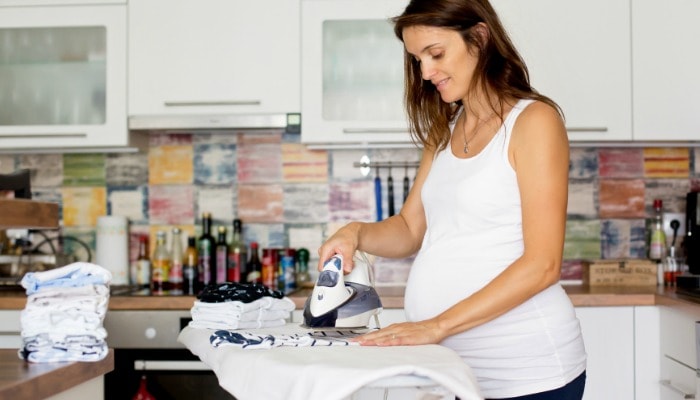
Active Labor
Active labor is when the cervix has opened to at least 6 centimeters (give or take), contractions are around 3-5 minutes apart, and each contraction is about 60 seconds long.
In early labor, women are able to walk and talk through their contractions. At this point, however, because contractions are longer, stronger and closer together, they can no longer walk and talk during contractions. Between contractions, she may still be her normal self and able to relax. During contractions, however, all her focus and energy goes within to work through the intensity of labor.
Many parents wonder how far apart contractions should be before heading to the hospital. Most parents go to the hospital during active labor and some wait until transition. Those that labor at home as long as possible are often working closely with their care providers to avoid a having a “car baby”. 😉
For a long list of symptoms of active labor, and tips to cope through it all, check out my post Active Labor: How to Cope, When to Go and More!
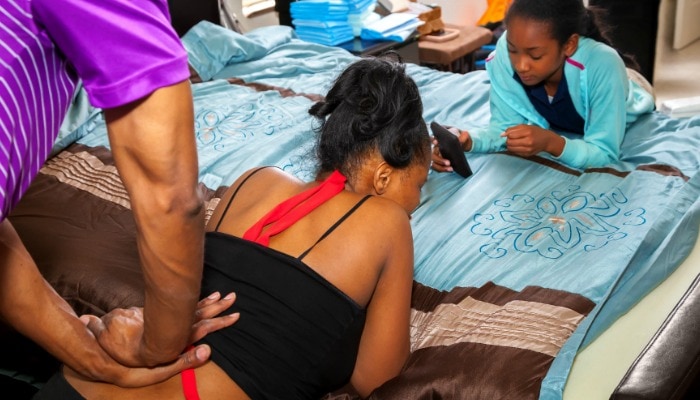
Transition
Transition is the shortest portion of the first stage of labor, but the most challenging. Contractions are around 90 seconds long, 2-3 minutes apart, and the cervix is 8 cm or more dilated.
At this point, a woman’s entire focus continues to be required for each contraction. However, unlike active labor, during transition women continue to stay “in the zone” even between contractions. When a woman is totally focused even between contractions, I know we’re making progress.
Transition is when some women “give up” on a natural birth, ask for an epidural, and say “I can’t do this anymore.” Birth plans fly out the window, and women look for a way out. Women may feel hot, cold, sweaty, nauseous, and may even throw up. Crying is another sign that she’s in transition.
At this point, what may have been working is absolutely not working anymore, which means a woman’s support team needs to step up their game.
For a more detailed post and MUST READ information about transition and how to cope through it, check out my post called how to get through transition without an epidural.
(Seriously… read it! And read the comments too – they’re amazing and so encouraging!)
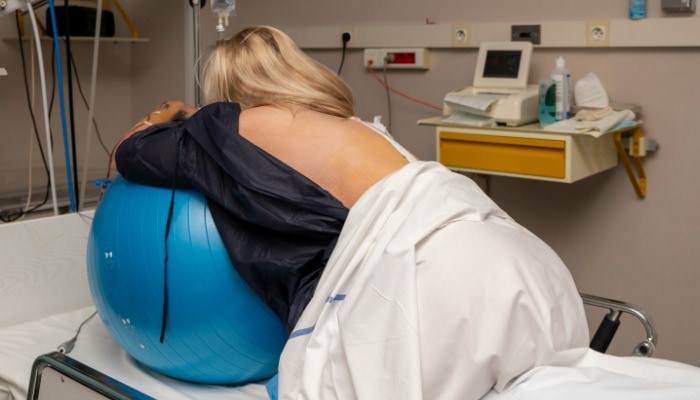
First Stage of Labor Frequently Asked Questions
Do you have questions about the first stage of labor? I’ve got answers! Let’s keep going.
How Long Does the First Stage of Labor Last?
The average first time mom will spend around 15-17 hours in labor, and most of that time is spent in the first stage of labor.
Can the First Stage of Labor Start and Stop?
Real labor contractions progressively get longer, stronger, and closer together and don’t go away with hydration, rest, or a shower. If a woman is experiencing a start and stop pattern of contractions, she may be experiencing pre-labor or prodromal labor.
The following graphic is helpful to visualize the spectrum of labor.
Can the First Stage of Labor Last for Days?
Yes, the first stage of labor can last for days. However, a marathon labor isn’t the average birthing experience.
If a woman is experiencing a 40+ hour labor, something’s not quite right. Two common reasons for long, non-progressing labors are inductions and babies being in non-optimal fetal positions.
Which Stage of Labor Is Most Painful?
The least painful stage of labor is the third stage, the delivery of the placenta. Also, many women report enjoying the second stage of labor, pushing and delivery, much more than the first stage. Because of this, we can probably conclude that the first stage of labor is the most painful.

What Are Some Signs That Labor Is Nearing?
One way to look at the onset of labor is by comparing it to becoming sick. Some people become sick quickly – they wake up in the middle of the night, throw up, and immediately feel achey with a fever. It’s obvious that they are sick!
Others, may feel sniffly for a day or two, after that a mild sore throat sets in, but it’s not until a few days later that the energy levels drop and bed rest is needed. Looking back, it is easy to see when the sickness began, but at the beginning, symptoms were so mild it was difficult to determine if it was sickness or just something else. It could very well have been allergies, but a few days in it became obvious that it was actually a virus.
Just like sickness, determining if it’s signs of labor can be obvious or… NOT! Both, and everything in between is normal! Sometimes the best way to determine if you’re in labor is by hindsight – it’s 20/20!
Common signs of labor are:
- Dropping
- Nesting and Restlessness
- Irritability
- Back Ache
- Diarrhea
- A Spidey Sense
- Dilation
- Effacement
- Cervical Movement
- Bloody Show or Mucus Plug
- Contractions that become stronger, longer and closer together
- Water Breaking
Is it baby time or just more end of pregnancy symptoms? For a detailed description of the above symptoms, head on over to read more about the signs of labor.

What Does the First Stage of Labor Feel Like?
In early labor some women experience pain and pressure in their back, the lower abdomen, and or both. Some women describe early labor contractions like mild to moderate period cramps.
In active labor many women report the same sensations from early labor, just stronger, longer and closer together. Also, as labor progresses she may also experience pressure in the pelvis and hips.
During transition contractions feel the same as before, just more intense. If she was feeling back pain, it’s more intense than before. If she was feeling pressure in the pelvis, it’s greater now. Suppose she was feeling all the pain and intensity in the front of the belly, it’s just that much more intense in transition.
At this point, the intensity of contractions is overwhelming and most women need extra support.
- Instead of completely going away contractions sometimes “double peak”
- Contractions increase when changing positions
- Because of this she may be afraid to move or change positions
During transition I often felt like something wasn’t working correctly. It seemed like things were hurting far worse than they should and that I wasn’t progressing quickly enough. The cost was far outweighing the perceived benefit. I found it helpful for people to remind me that things were progressing normally, instead of slowly. When you’re in labor, it is hard to have an accurate sense of time. During transition, reminders and encouragement are so helpful.
Curious about what contractions feel like? Hop on over to read more about what other parents say contractions feel like.
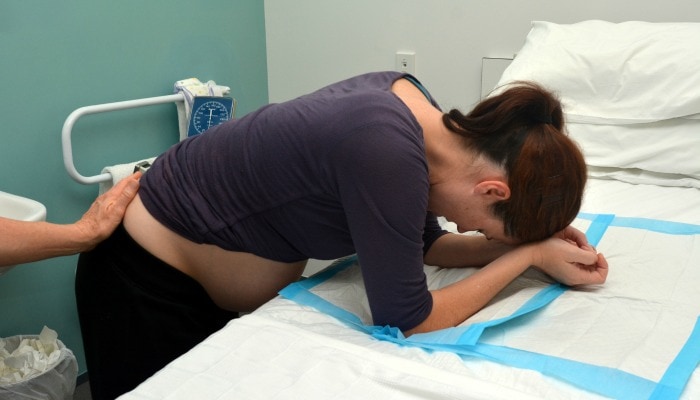
What Are the Symptoms of the First Stage of Labor?
Symptoms of the first stage of labor are:
- Dilation
- Effacement
- Cervical movement from a posterior to an anterior position
- Contractions that become longer, stronger, and closer together
- Baby dropping further into the pelvis
- Diarrhea
- Back ache
- Pelvic pressure
- Bloody show or mucus plug
- Water breaking
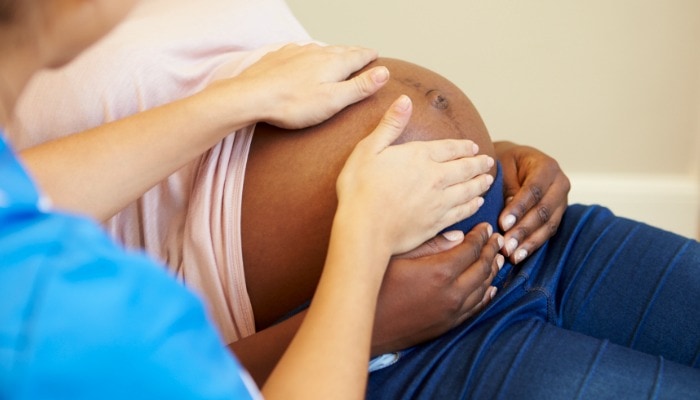
Is the Mucus Plug a Sign of the First Stage Labor?
I hate to be the bearer of bad news, but losing the mucus plug does not mean that labor will start right now. Ladies, if you lose your plug, don’t get your hopes up that labor will begin TODAY. Losing the mucus plug in and of itself does not mean that labor is immenent.
All a mucus plug can communicate to someone is that they’re going to have a baby “soon”. However, you likely already know this as most women losing their plug are closer to 40 weeks gestation.
Losing the mucus plug along with other signs of labor is a better indication that it’s baby time.
For example, if you go to the bathroom, wipe and see mucus plug AND begin to have contractions 5-7 minutes apart there’s a good chance that you’re in the first stage of labor.
FYI: Towards the end of pregnancy, vaginal exams, stripping the membranes, and sexual intercourse can dislodge the plug. After any of these activities women may experience more mucousy discharge than normal, sometimes tinged with blood and sometimes without.
TIP: Hop on over here to see what a mucus plug looks like.
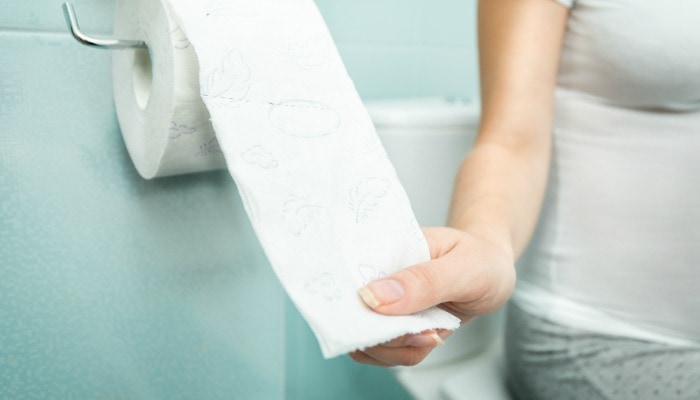
What Is the 511 Rule for Contractions?
One of the biggest concerns parents have about childbirth is knowing when it’s time to go to the hospital. Believe it or not, many are worried about accidentally giving birth in the car!
Many care providers offer 511 as a rule of thumb to help get parents to the hospital in time.
- Contractions are 5 minutes a part
- Each contraction is around 1 minute
- This has been going on for 1 hour
First Stage of Labor 101 for the First Time Parent
The first stage of labor transitions parents from the end of pregnancy to the pushing stage of labor. It can be long, and quite challenging. However, the rewards are great! Remember, you can do it!
